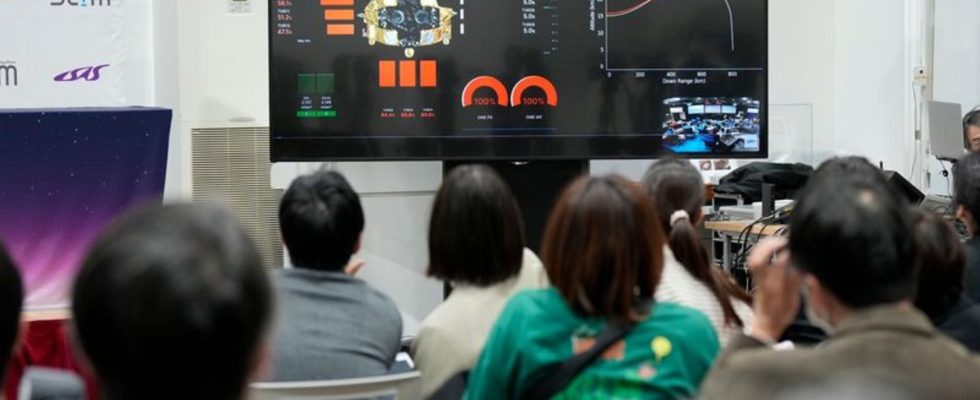Japan seems to have succeeded in a soft landing on the moon. However, a component of the “SLIM” lander is causing problems. The end of the “Peregrine” capsule, which failed to make the first commercial moon landing, is sealed.
As of Friday evening, Japan had succeeded in its planned soft landing on the moon – but there were problems with the energy supply. The solar panel does not provide any electricity, it was said at a press conference with experts from Japan’s space agency Jaxa.
The “SLIM” (Smart Lander for Investigating Moon) lander is still communicating with the ground station and receiving data. The battery capacity is expected to last for a few hours, so as much data as possible should be obtained.
If the status of a soft landing remains, Japan will be the fifth country to achieve a soft landing on Earth’s satellite after the former Soviet Union, the USA, China and India.
Further findings can only be expected with new evaluations, it was said in the evening. As things stand, the solar panel is not damaged. It initially remained unclear whether there was an unfavorable alignment or other problems. Likewise, whether there is a solution and whether the panel could still supply electricity soon. It was also not yet possible to say whether the unmanned landing took place as planned within a zone of 100 meters.
“Peregrine” mission is repeated
Last April, a private Japanese company failed in a similar mission. The reason given by the company Ispace was an incorrect altitude calculation of the lander.
Around ten days ago, the US company Astrobotic failed to successfully send off the “Peregrine” lander. The US mission started successfully, but then there were problems with the propulsion system. The engineers temporarily managed to stabilize the capsule, but the goal of a moon landing had to be abandoned. A valve probably didn’t work properly, Astrobotic boss John Thornton said at a press conference. It would have been the first private landing on the moon.
After consultation with the US space agency Nasa, among others, Astrobotic decided to allow the capsule to crash in a controlled manner on Thursday – among other things to avoid the risk of uncontrolled space debris flying around, as Thornton said. As expected, on Thursday around 10 p.m. CET, contact with the capsule was lost. This indicates that the capsule crashed in a controlled manner over the South Pacific as planned and burned up in the Earth’s atmosphere. There is now independent confirmation of this.
Astrobotic wants to start the next experiment at the end of the year: Then the “Griffin” lander should be sent to the moon, including with a NASA rover on board. The launch is currently planned for November, but before that the problems with “Peregrine” still need to be thoroughly investigated.
“SLIM” has been on the road since September
The Japanese lander “SLIM” set off for the moon from the Japanese Tanegashima spaceport last September on board an H2A carrier rocket. Japan’s space agency Jaxa had hoped that a successful precision landing of the 2.4-meter-tall probe would usher in the transition from an era of “landing where we can” to an era of “landing where we want.”
SLIM’s pinpoint landing capability and information on the surface properties of the moon will be used in future lunar missions, for example as part of the US-led Artemis program. NASA wants to bring people to the moon again after more than 50 years – although the lunar landing mission “Artemis 3” was postponed to September 2026 just last week.
Experts attribute the problems with today’s moon landings, among other things, to the fact that a lot of knowledge has been lost since the missions in the late 1960s and early 1970s. The researchers and engineers involved at the time are now very old or dead and can no longer contribute their knowledge, Ulrich Walter, professor of space technology at the Technical University of Munich and former astronaut, recently explained. “We’re basically starting from scratch these days.”
Lunar modules are now equipped with a lot more software than before. This does have advantages, for example flight maneuvers can be adjusted spontaneously. On the other hand, software is also prone to errors. “I estimate that around half of the failed moon landings in recent years were due to faulty software,” said Walter.
Japan wants to become an indispensable partner
China and India in particular have benefited from the fact that they have been continuously developing their space travel for several decades, says Walter. According to the Chinese government’s plans, compatriots should be standing on the moon by 2030 – if there are further delays in the “Artemis” program, it is not inconceivable that they will be walking around there sooner than the first new US moonwalkers.
According to the Japanese business newspaper “Nikkei Asia”, the missions related to “SLIM” include a joint project with India to explore water resources in the polar regions in 2025. In addition, the car giant Toyota Motor and the Mitsubishi Heavy Industries (MHI) group are developing a rover for the use of astronauts on the moon. Both companies are expected to begin developing a model this year, which should launch in 2029.
In contrast to the USA, India or China, Japan does not have the financial means to carry out large space missions itself, according to the “Nikkei Asia”. Japan’s strategy is therefore to develop technologies and become an indispensable partner.

